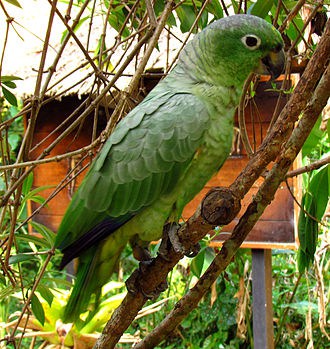Type the name of the breed you're looking for below
[wpdreams_ajaxsearchlite] Don't see the breed your're looking for? Click here and let us know!
Mealy Amazon Parrot
| Origin | The Mealy Amazon occurs in tropical Central America and South America. |
| Size | This species can grow up to 15 in(38 cm) |
| Lifespan | Can live up to 80 years |
| Noise | Moderate, talkative birds. |
| Characteristics | The back and nape often have a whitish tinge; almost as if it had been covered in a thin layer of flour ("meal"; hence its name). The distal half of the tail is paler and more yellow than the basal half, thus resulting in a distinctly bi-colored look. In flight it shows a bluish-black trailing edge to the wing and a conspicuous red speculum. Occasionally a few yellow feathers are apparent on the top of the head and two subspecies, virenticeps and guatemalae, have a bluish-tinged crown. The maroon to orange eyes (which typically appear dark from a distance) are surrounded by a relatively broad white eye-ring of bare skin. |
| Abilities | Can talk or mimic human conversation. |
| Interaction/Time Requirements, Diet, Supplies Needed | A large cage is required even if the bird is going to spend lots of time out of its habitat with you. They require a warm habitat for the winter months. Do not allow your birds outdoors until all signs of frost are gone. Space is important and indoor cages should be as large as possible. Their diet in the wild consists of mainly fruits, wild figs, unripe nuts, flower and leaf buds, and some seeds. In captivity, they will eat most fruits including mangos, figs, guavas, bananas, melons, stone fruits, grapes, citrus fruits, pears, apples, pomegranate and papaya (pawpaw). You need to change food and water daily, and clean the cage at least once a week, replacing toys and broken climbing branches. Parrots do well in aviaries and cages. They don't like to be in crowded spaces and will sometimes be aggressive towards other birds if they don't have enough space. |
| Other Considerations | Parrots can also be hand reared, provided that they have a large cage and are taken out of their cage on a daily basis to prevent boredom, as it may result in the parrot pulling out its feathers to occupy itself. |



